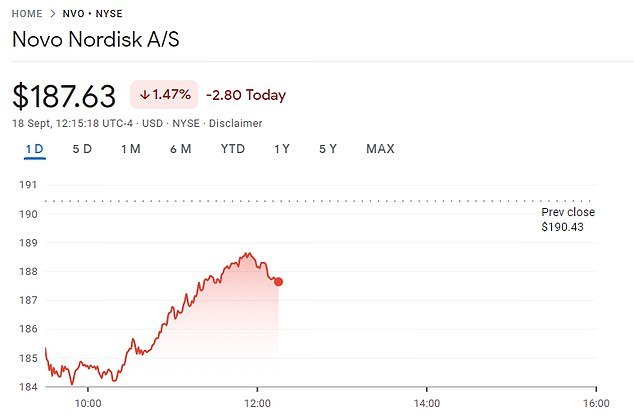An Ozempic and Wegovy plant in North Carolina that helps serve millions of Americans has failed inspection, reports show.
The Food and Drug Administration (FDA) determined that the factory had “offensive” conditions.
The drugmaker, based in Clayton, North Carolina, now has three weeks to create an action plan to resolve the issues or risk further action. Novo Nordisk, owner of the factory, says production “continues.”
The Danish company behind hit weight-loss drugs Ozempic and Wegovy has rapidly expanded its manufacturing capacity to meet rising demand ? with five million prescriptions for its weight-loss drugs written in the US alone last year.
The increase led to major shortages of the drugs earlier this year, prompting pharmacies to mix their own versions.
Novo Nordisk now has three weeks to draw up an action plan to resolve the issues or risk further action. Pictured above is the factory

Novo Nordisk’s stock price fell nearly three percent on Monday before rising to $187.63 per share
The report, from financial news agency According to sources, the factory has been issued a Form 483.
This is given to companies when inspectors from the FDA’s Office of Regulatory Affairs observe conditions in manufacturing facilities that they deem “offensive.”
The reason why Novo Nordisk was issued the form has not been made public, but some objectionable conditions listed on Form 483 include dirty or damaged equipment, improper storage of medications, or inadequate paperwork.
It is believed that the FDA inspectors visited as part of a routine inspection, which the agency does to ensure factories are adhering to standards.
When the report was unveiled, the company’s share price fell three percent, although it has now risen to $187.63 per share.
The Novo Nordisk site in Clayton includes a facility responsible for the production of semaglutide, the active ingredient in Wegovy and Ozempic.
This factory opened in 2021 and was the first location outside Denmark that the company built to manufacture the drug. It is approximately 400,000 square meters, or the size of seven football fields.
There is also a second factory responsible for assembling and packaging medicines, including Ozempic and Wegovy.
These plants are believed to be responsible for much of the U.S. supply of Ozempic and Wegovy, with disruption of the plant risking shortages of the drugs.
The FDA currently still lists four semaglutide injections ? three for Wegovy and one for Ozempic ? as having limited availability.
Two Ozempic recordings are also listed as ‘currently available’.
Novo Nordisk, based in Denmark, has declined to comment on the reports but said the factory was still “running and producing for the market.”
The FDA did not respond to requests for comment but typically does not comment on individual companies.
Novo Nordisk also has a third manufacturing facility in the area, 40 miles away in Durham tablet version of semaglutide – sold under the brand name Rybelsus.
Ozempic has taken America by storm because of its promise to help someone shed the pounds with just one injection a week.
The drug is approved for the treatment of type 2 diabetes and is also prescribed off-label to other people to help them lose weight.
It works by suppressing feelings of hunger and slowing down the digestive system, causing a person to eat less because they feel full longer. This leads to weight loss.
It comes after an analysis found that Ozempic, Wegovy and Rybelsus are up to ten times more expensive in the US than in other rich countries.
A 10-country price analysis by the Kaiser Family Foundation (KFF) found that a one-month supply of Ozempic ? which is approved for the treatment of diabetes but often prescribed off-label for weight loss ? has a suggested retail price of $ 936. .
A list price is the price that the drug manufacturer publicly charges when selling to wholesalers, who buy drugs from manufacturers to sell to pharmacies, hospitals and clinics.
Although the list price does not necessarily reflect what consumers will pay, patients often have to pay more to offset the price set by manufacturers.
